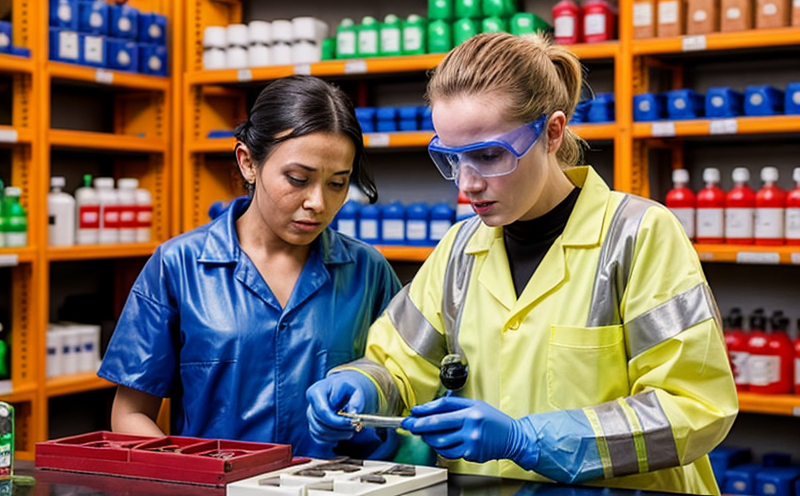EN 15205 VOC Emission Testing in Hazardous Chemical Goods
The European standard EN 15205:2008 outlines the procedures for measuring volatile organic compounds (VOCs) emissions from hazardous chemical goods. This testing is crucial to ensure compliance with environmental regulations and standards, particularly in industries dealing with chemicals that might pose a risk if their VOC content exceeds permissible limits.
The standard applies primarily to solid and liquid materials packaged or intended to be packed into packages for transport. The test aims at identifying potential hazards related to the emission of volatile organic compounds during storage and transport conditions. By assessing these emissions, manufacturers can ensure that their products meet stringent environmental requirements set by regulatory bodies across Europe.
The testing process involves placing the sample in a climate-controlled chamber where it is exposed to specific temperature and humidity conditions for an extended period. The emitted VOCs are then captured using adsorbent materials or other suitable collection methods, followed by analysis via gas chromatography-mass spectrometry (GC-MS). This sophisticated technique allows for accurate quantification of various VOC species present in the sample.
Understanding the importance of this test is essential for stakeholders involved in chemical goods production and distribution. Quality managers need to ensure that their products comply with international standards like EN 15205, while compliance officers must verify adherence to local regulations. R&D engineers can leverage these tests to optimize formulations, improve product safety, and enhance environmental friendliness.
For procurement teams, understanding the implications of VOC emissions helps them select suppliers who adhere strictly to such stringent testing protocols. Proper implementation not only minimizes risks associated with non-compliant goods but also enhances brand reputation by demonstrating commitment to sustainability initiatives.
The significance of this test extends beyond mere compliance; it plays a pivotal role in safeguarding public health and preserving natural environments from adverse impacts caused by excessive VOC emissions. As global environmental concerns continue to grow, adopting practices aligned with standards like EN 15205 becomes increasingly important for maintaining industry credibility.
Given the complexity involved in measuring VOCs accurately, it is advisable to partner with reputable laboratories equipped with state-of-the-art facilities and experienced personnel capable of handling such specialized tests. Such partnerships ensure reliable results that can be trusted when making critical decisions about product formulations or supply chain management strategies.
Scope and Methodology
| Test Parameters | Details |
|---|---|
| VOC Species Identification | The test identifies various types of volatile organic compounds present in the sample. These include alcohols, ketones, esters, and other common hydrocarbons. |
| Emission Rate Measurement | This involves quantifying the amount of VOCs released from the sample over a specified period under controlled conditions. |
| Instrumentation & Techniques | Description |
|---|---|
| Gas Chromatography-Mass Spectrometry (GC-MS) | An advanced analytical technique used to separate and identify individual VOCs based on their chemical properties. |
| Climate-Controlled Chamber | A specialized enclosure designed to maintain precise temperature and humidity levels during the testing process. |
The scope of EN 15205 covers a wide range of hazardous chemical goods, including paints, coatings, adhesives, sealants, and varnishes. It is important to note that this standard does not apply to products intended for direct human consumption or use as food additives.
In order to ensure accurate results, it is recommended that samples undergo rigorous pre-processing steps before being placed inside the climate-controlled chamber. This may include cutting down large volumes of materials into smaller pieces suitable for testing and ensuring that all packaging has been removed.
Customer Impact and Satisfaction
Implementing EN 15205 VOC emission testing offers numerous benefits to customers, including enhanced product safety, improved reputation, and increased market competitiveness. By adhering to this standard, companies demonstrate their commitment to environmental responsibility and public health.
Compliance with EN 15205 helps reduce the risk of regulatory penalties and potential lawsuits related to non-compliant products. It also fosters trust among customers who value sustainability, thereby enhancing overall customer satisfaction levels.
The accurate identification and quantification of VOC emissions enable manufacturers to make informed decisions regarding formulation adjustments or process improvements aimed at reducing harmful effects on both people and the environment. This proactive approach contributes significantly towards maintaining a positive image in the market place.
Moreover, by ensuring that their products meet international standards like EN 15205, companies position themselves favorably against competitors who may not prioritize similar measures. This strategic advantage translates into higher sales volumes and stronger customer loyalty over time.
International Acceptance and Recognition
The European standard EN 15205:2008 has gained widespread acceptance not only within the EU but also in many other countries around the world. Its rigorous approach to measuring VOC emissions makes it a preferred choice for industries dealing with hazardous chemical goods.
Multinational corporations often opt for EN 15205 certification as part of their global quality assurance programs. This standard serves as an essential benchmark for ensuring consistent product performance across different regions and markets.
Many governments worldwide have adopted or referenced EN 15205 in their national legislation, further cementing its status as a leading reference point for VOC emission testing in hazardous chemical goods. Compliance with this international standard enhances the credibility of manufacturers and suppliers operating within these jurisdictions.





